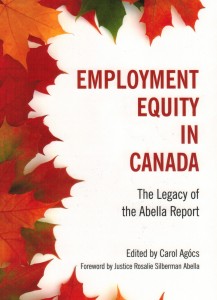When Parliament passed the Employment Equity Act in 1986 the Globe & Mail celebrated it as an initiative “aimed at making the workplace fairer for women, the disabled and visible minorities.”
And yet –
In 170 years the Globe has never hired an editor-in-chief who was not a white male. Such ironies abound in Employment Equity In Canada, a snappy account of the nation’s struggle with jobsite discrimination. Officialdom never called it affirmative action – “It proved to be a polarizing term”, Equity notes – nor did the program ever approach the scope and intensity of its U.S. cousin. The fact the Act is now in its third decade with little comment from Parliament says plenty.
Equity is both celebratory and despairing. If the Canadian law became a template for legislators in Australia, South Africa and Northern Ireland, it did little good for 95 percent of Canadians exempt from it in the first place. Even for employers subject to the Act improvements have been spotty.
“The group that lags behind most is persons with disabilities,” Equity says; “Representation has always been significantly below availability.” In the first year the Act advocates calculated the disabled comprised less than 1 percent of new hires at Canada’s largest employers: Canada Post; CBC; Bell Canada; Canadian National Railway Co. and the Big Five banks. “We Canadians like to think of ourselves as very tolerant and socially progressive, but on employment equity we need to be wary of arrogance,” Equity concludes.
The Act was born from a one-woman 1983 royal commission led by Rosalie Abella, then a family court judge from Toronto. Abella travelled with a staff of one, conducting interviews with a tape recorder rather than holding formal hearings: “Participants were told they would not be quoted without their approval, but were free to discuss their issues with the media if they wished.”
Abella met with advocates, business and labour in the kind of consensus-building initiative now disregarded in Ottawa as “red tape”. The resulting Act had much promise and is credited with inspiring a string of Supreme Court judgments that made working life fairer for minorities.
And yet –
Companies with fewer than 100 employees were exempted, representing most worksites. The Act tended to benefit workers who were covered by collective agreements anyway. It did no good for the fastest-growing segments of the workforce – part-timers and the self-employed – and a provision that it apply to federal contractors awarded tenders worth $200,000 or more was rolled back to $1 million in 2013.
“Complaint-based enforcement is not suitable for people in precarious work: not only might they lack the knowledge and skills to make a complaint, they may be particularly fearful of losing their job,” writes contributor Patricia Hughes, executive director of the Law Commission of Ontario. “They may be concerned about immigration authorities and repatriation.”
The minimum wage clerk, the migrant farmworker, the nanny – all could accurately say the Act did not improve their lot. Perhaps it was asking too much, Hughes writes: “No single policy remedy will fully address discrimination in the workplace, nor will one approach address the situation of vulnerable workers.”
Readers are left to wonder: in its 171st year, might the Globe find a candidate clever enough to edit the newspaper who is not white, and not male.
By Holly Doan
Employment Equity In Canada: The Legacy Of The Abella Report, edited by Carol Agocs; University of Toronto Press; 352 pages; ISBN #9781-4426-15625; $21.91






